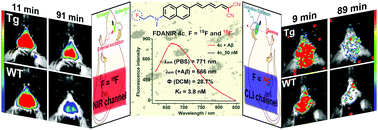In vivo near-infrared and Cerenkov luminescence imaging of amyloid-β deposits in the brain: a fluorinated small molecule used for dual-modality imaging†
Abstract
Three fluorinated (19F or 18F) small molecules were evaluated as fluorescent or radiolabeled probes for Aβ deposits in the brain. In vivo near-infrared imaging suggested that probe 4c could efficiently distinguish between transgenic mice and wild-type controls. Furthermore, the in vivo Cerenkov luminescence imaging with [18F]4c showed modest differences between the two groups.


 Please wait while we load your content...
Please wait while we load your content...